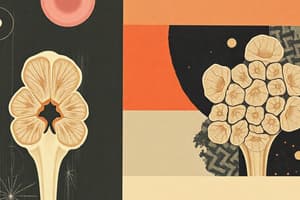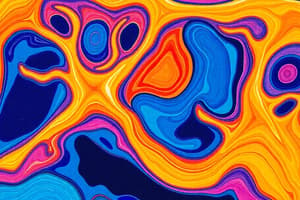Podcast
Questions and Answers
What is the primary component of the extracellular matrix (ECM) of hyaline cartilage that contributes to its structural integrity?
What is the primary component of the extracellular matrix (ECM) of hyaline cartilage that contributes to its structural integrity?
- Type II collagen (correct)
- Elastin
- Fibrin
- Type I collagen
What type of growth involves the formation of new chondroblasts from progenitor cells in the perichondrium?
What type of growth involves the formation of new chondroblasts from progenitor cells in the perichondrium?
- Radial growth
- Intermittent growth
- Appositional growth (correct)
- Mitosis growth
Which property of glycosaminoglycans contributes to the shock-absorbing characteristics of cartilage?
Which property of glycosaminoglycans contributes to the shock-absorbing characteristics of cartilage?
- Hydrophobic interaction with lipids
- Ability to bind anions (correct)
- Ability to bind cations
- Electrostatic interaction with collagen type I
What are the primary cells found in the lacunae of cartilage?
What are the primary cells found in the lacunae of cartilage?
What is a significant factor contributing to the slow repair of cartilage after injury?
What is a significant factor contributing to the slow repair of cartilage after injury?
Which of the following statements about the ECM of cartilage is incorrect?
Which of the following statements about the ECM of cartilage is incorrect?
What is the primary source of mesenchymal progenitor cells activated for the repair of damaged hyaline cartilage?
What is the primary source of mesenchymal progenitor cells activated for the repair of damaged hyaline cartilage?
What distinguishes hyaline cartilage from most other connective tissues?
What distinguishes hyaline cartilage from most other connective tissues?
What is the primary function of chondrocytes within the cartilage ECM?
What is the primary function of chondrocytes within the cartilage ECM?
What type of collagen is primarily found in hyaline cartilage?
What type of collagen is primarily found in hyaline cartilage?
How do proteoglycans contribute to the physical properties of cartilage?
How do proteoglycans contribute to the physical properties of cartilage?
Which factor does NOT contribute to cartilage degeneration?
Which factor does NOT contribute to cartilage degeneration?
What structural characteristic differentiates the three main types of cartilage?
What structural characteristic differentiates the three main types of cartilage?
What is the role of hyaluronan in cartilage?
What is the role of hyaluronan in cartilage?
What is a significant consequence of cartilage lacking perichondrium?
What is a significant consequence of cartilage lacking perichondrium?
Which of the following is NOT a type of cartilage?
Which of the following is NOT a type of cartilage?
What is the primary type of collagen found in hyaline cartilage?
What is the primary type of collagen found in hyaline cartilage?
What role do proteoglycans play in hyaline cartilage?
What role do proteoglycans play in hyaline cartilage?
What is a significant consequence of osteoarthritis affecting hyaline cartilage?
What is a significant consequence of osteoarthritis affecting hyaline cartilage?
Which factor is NOT associated with the degeneration of cartilage in joints?
Which factor is NOT associated with the degeneration of cartilage in joints?
What components form the structure of proteoglycans in hyaline cartilage?
What components form the structure of proteoglycans in hyaline cartilage?
What percentage of the weight of fresh hyaline cartilage is constituted by water bound to GAGs?
What percentage of the weight of fresh hyaline cartilage is constituted by water bound to GAGs?
What effect does aging have on hyaline cartilage in joints?
What effect does aging have on hyaline cartilage in joints?
Which type of cartilage is primarily found in places like the ribs, ears, and nose?
Which type of cartilage is primarily found in places like the ribs, ears, and nose?
Flashcards are hidden until you start studying
Study Notes
Cartilage Types and Function
- Cartilage provides structural support in joints, ribs, ears, and nose.
- Main types of cartilage: hyaline, elastic, and fibrocartilage, each with specific functions and features.
Structure and Composition
- Hyaline cartilage contains predominantly type II collagen and a high concentration of water (60%-80% of its weight).
- Proteoglycans, such as aggrecan, play a critical role in cartilage's structural integrity and shock-absorbing properties.
- Chondrocytes, embedded in the extracellular matrix (ECM), produce and maintain cartilage components.
Medical Relevance
- Osteoarthritis is a progressive disease characterized by the degeneration of hyaline cartilage, especially in weight-bearing joints like hips and knees.
- The disease triggers inflammation through matrix metalloproteinases and immune responses, leading to pain.
Growth and Repair
- Cartilage grows via interstitial (mitosis of existing chondrocytes) and appositional (formation of new chondroblasts) growth.
- Repair of damaged cartilage is limited due to its avascular nature and low metabolic rate.
Mechanical Properties
- Cartilage's semi-rigid consistency is maintained by electrostatic interactions between collagen, hyaluronan, and glycosaminoglycans (GAGs).
- This structure allows it to withstand mechanical stresses and provides a smooth surface for joint movement.
Differences in Cartilage Types
- Hyaline cartilage has a glassy appearance and homogenous ECM, which is rich in type II collagen and proteoglycans.
- Elastic cartilage contains elastin fibers, providing flexibility, while fibrocartilage, rich in dense collagen, offers toughness and strength in areas like intervertebral discs.
Chondrocyte Function
- Chondrocytes reside in cavities called lacunae and are the primary cells responsible for synthesizing cartilage ECM.
- Chondrocytes function is compromised by genetic conditions, leading to deformities or joint issues.
Cartilage and Aging
- As individuals age, the properties of hyaline cartilage change, affecting joint mobility and contributing to degenerative diseases.
- Factors like wear-and-tear contribute to cartilage wear and the development of conditions like osteoarthritis.
Studying That Suits You
Use AI to generate personalized quizzes and flashcards to suit your learning preferences.




